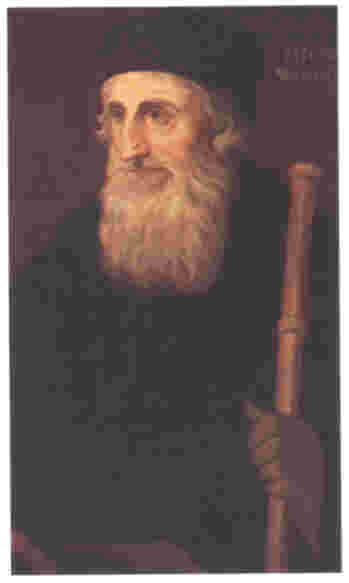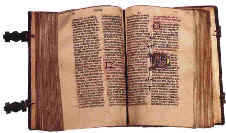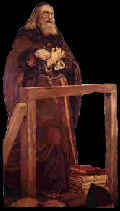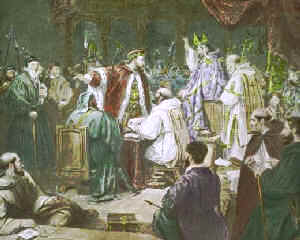
| 1 |
2 |
3 |
4 |
5 |
6 |
7 |
|
Ephesus |
Smyrna |
Pergamos |
Thyatira |
Sardis |
Philadelphia |
Laodicea |
|
"First,
Desirable" |
"Bitter
Affliction" |
"Earthly
Heighth" |
"Sacrifice
of Labor" |
"Prince
of Joy" |
"Love
of A Brother" |
"Just
People" |
|
33-70 AD |
70-313 |
313-1157 |
1157-1367 |
1367-1517 |
1517-1874 |
1874-? |
Paul
35-64 AD |
John
70-100 |
Arius
313-336 |
Waldo
1157-1217 |
Wycliffe
1367-1384 |
Luther
1517-1546 |
Russell
1874-1916 |
|
7 Golden
Candlesticks |
First & Last,
Dead and Alive |
Sharp 2-Edged
Sword |
Eyes like Fire,
Feet like Brass |
Livest and
Art Dead |
Key of David |
Amen,
Faithful and True
Beginning of Creation |
|
Left 1st Love |
Synagogue of
Satan |
Antipas |
Jezebel |
Come as Thief |
Hast Little
Strength |
Lukewarm |
|
Nicolaitanes |
Tribulation 10
Days |
Balaam &
Balac,
Nicolaitanes |
Depths of Satan |
Defiled Garments |
Keep from Hour of
Temptation,
Hold Fast Crown |
Gold Tried,
White Raiment Eyesalve,
Knock at Door,
Sup with Him |
|
Tree of Life |
Crown of Life,
Not Hurt of 2nd Death |
Hidden Manna
White Stone,
New Name |
Rod of Iron,
Potter's Vessel
Morning Star |
White Raiment,
Confess Name to Father |
Pillar in Temple,
Name of God, New Jerusalem, & New Name |
Sit in Christ's
Throne |
For more detail, click on
individual Church name.

Church of Sardis
Revelation 3:1-4
Roughly between CE 1378-1528.
Sardis was a city of Asia Minor, formerly the
capital of that
wealthy monarch Croesus, king of Lydians.
It is difficult to ascertain the meaning of the name Sardis, but
Benjamin Wilson in his appendix of the Diaglott provides a different explanation than the
traditional "that which remains." He says it means "prince
of joy." While this was not a joyous period for the true people of God, it
was a time when Christ’s sacrifice, who indeed was the "Prince of joy,"
began to be seen as a "once for all" sacrifice.

The Seven Churches
"And unto the angel [Wycliff] of the
church in Sardis write: These things saith he that hath the seven
Spirits
of God [Jesus has the "seven Spirits of God" here even though
he does not receive them until Revelation 5:6], and the seven stars; I
know thy works, that thou hast a name that thou livest, and art dead.
"Be watchful, and strengthen the things which
remain, that are ready to die: for I have not found thy works perfect
before God.
"Remember therefore how thou hast received and heard, and
hold fast, and repent. If therefore thou shalt not watch, I will
come on thee as a thief, and thou shalt not know what hour I will come
upon thee.
"Thou hast a few names even in Sardis, which
have not defiled their garments; and they shall walk with me in white:
for they are worthy." Revelation 3:1-4
|
The
"Sardis" messenger was John Wycliff of this period.
Significant changes began taking place when Wycliff commenced his
ministry. The year of the Schism was 1378, when two popes claimed to be head of the
church—one in Rome and one in Avignon. The Schism provided an opportunity to see what the
papal church was all about.
Up until 1378, Wycliff had been occupied in a mixed way with religious
and political matters. However, 1378 marked the turning point for him, when he focused
only on doctrinal matters.
|

John Wycliff (1320-1384) |
|
Wycliff published the New Testament in English in 1378
and finished the Old Testament before he died.
He also wrote some 200 articles mainly defending the ransom. Wycliff
spoke out against the doctrine of Transubstantiation, the main teaching of the Catholic
Church.

1440 edition of hand-written
Wycliff
Bible. |

Page from the Wycliff Bible |
|
Wycliff's success may have been due in part to the problems the papacy was having with two
popes striving for ascendancy.
They had enough of their own problems within, without trying to quench
the brush fires started by Wycliff.
Three papal bulls were issued before the Great Schism to deal with Wycliff’s alleged heresy. The very year Pope Gregory XI died, both Urban VI and
Clement VII (Robert of Geneva) claimed to be Christ’s vicar.
At Wycliff’s trial, two powerful princes accompanied him, to
prevent his execution. The Lord prevented the powers of darkness from destroying the
needful work of this Reformer.
|

Wycliff's trial in London
in 1377
ended in a riot. |

Wycliff before the Council
|
Wycliff had attacked the doctrine of Transubstantiation that
took away the efficacy of Christ’s one sacrifice for sin. However, this
period was not a happy time for conversion to take place. While the Bible emerged in
English, few Bibles were available and still fewer people could read.
It was at this time that Revelation 8:13 began, and
the
first of three "woes" began to be heard by the inhabitants of the earth.
Conditions were such that people who really wished to step out of the shackles of false
religion were made uncomfortable by the flashes of light emanating at that time, but not
able to fulfill their desire to have a true conversion. This period, while it brought some
light, did not provide the conditions necessary for Christian conversion and growth on a
larger scale. Even the Lutheran reform of 1517 did not provide a strong climate for reform
until 1528. No one knew how the Reformation would eventuate.
"When They Shall Fall,
They Shall Be Holpen with a Little Help."
Daniel 11:34
The year 1528 was not only a critical year
for Protestantism in England, but also in Germany. Charles V, Roman emperor of
Germany, had risen to power, and this emboldened Pope Clement VII (Giulio De’ Medici)
to induce Charles V to limit the spread of Protestantism.
Under the proposed law, no Protestant was to convert a Romanist
to the reformed faith, nor would it be allowable for Protestantism to spread to other
countries. It meant for all Protestants an end such as
with the Huguenots who came to in
France, the suppression of the Renaissance with its "increase of knowledge," and
the end of the prosperous and comparatively enlightened civilization of modern times.

Huguenots at
St. Bartholomew's Massacre
|
The future of the whole world, and of the Divine
Plan, was at stake! A general war was barely avoided to destroy Lutheranism. Philip
Landgrave of Saxony discovered the plot, took arms, and in 1528 forced indemnity from a
Catholic bishop. Other princes of Germany stood with Philip (MARTIN
LUTHER, Vol. II, p. 486).
Quoting from MARTIN LUTHER, by Dr. Peter Bayne, LL. D., Vol. II, p. 486:
"These (the princes of the
reformed faith) were inflexibly determined that the decree of the majority should not be
assented to. Philip of Hesse, John of Saxony, Markgraf George the Pious of
Brandenburg/Anspach, the Dukes of Lunenburg and Brunswick, the Prince of Anhalt, and the
representatives of Strasburg, Nurnberg and twelve other free cities, entered a
solemn protest against the prospective revolution. They were called Protestants! All
to this hour, who claim that Truth shall be unveiled, and that no Pope, or Kaiser, shall
congeal the ever-advancing stream of progress and improvement, may take an honorable pride
in tracing their spiritual descent to the intrepid Philip and the magnanimous and
simple-hearted John."
"The Diet of Spires, on the 27th of August,
1526, they [the papists] succeeded in practically obtaining their object. The Edict of
Worms, which had so long hung as a fiery portent and menace of coming wrath in the
political firmament of Germany, was not swept finally from the heavens, but it was veiled
in softening clouds of compromise and reservation."
(MARTIN LUTHER, Vol. II, p. 455)
The more liberal papists were willing to let those
areas where the Reformation had taken hold remain, and only wanted to stop the Reformation
from spreading to new areas. This was unacceptable to Protestants. However, it gave
Protestants a legal position in Germany. Then, in 1529 another Diet of Spires was held.
The reactionary papist leaders would have forced the Diet of 1526 back to the old Edict of
Worms with this provision:
"Where the Worms Edict had been enforced, it
was, they urged, to be maintained; but all further propagation of the reformed doctrines,
all religious innovation whatever, was to be forbidden, pending the assemblage of a
General Council. That is to say, the friends of Reformation were to accept defeat where
their adversaries declared themselves in the ascendant, and at the same time to abjure all
thought of progress." (MARTIN LUTHER, by Dr. Peter Bayne, LL.D., Vol. II, p.
484)
This papal plot formed the basis for
Protestants to form the League of Schmalkald, Feb. 27, 1531 and again in 1537
when the reforms drew up articles of common belief. (ENCYCLOPEDIA
BRITANNICA, 1945 edition, Vol. 20, p. 80) This League formed
a Protestant wall of defense against the alliance of Charles V and Pope Clement VII to
contain the Reformation.
Also, in 1528 Henry VIII of England wished an annulment from his wife
Queen Catherine of Aragon, aunt of Charles V. When the papal representatives Cardinals
Compeggio and Wolsey did not grant Henry VIII his desires, he began moving England away
from Rome.
Bad news for Pope Clement was coming from two fronts:
(1) the Protestant wall of
defense in Europe, and
(2) England's turning fortune
away from Rome.
In this critical time we see the window of opportunity opened to spread
the Reformation far and wide. It could not be contained or restrained any longer.
The period between 1378 and 1528 is the "five months"
(150 years) of Revelation 9:5 in which "death" or conversion eluded the
honest-hearted. They endured the "scorpion" sting which did not kill or
convert them, but only succeeded in tormenting their hearts and minds with the realization
that the door of opportunity for reform had not opened sufficiently for many of them to
enter.
The help that came to the Reformers was due
to the troubled conditions of the Papacy. First, Pope Clement VII found
himself engaged in warfare with the army of Charles V. He was taken prisoner and was
finally released in 1527. He came out from prison wiser, but not less hostile to
Protestants.
Fortune smiled upon Pope Clement VII when "Charles [V]
linked himself in bonds of family relationship with Clement, by bestowing upon
Clement’s nephew, Alexander de Medici, the hand of his natural daughter. Such was the
Treaty of Barcelona, signed June, 1529, by which the Vicegerent of Christ cut in before
his allies and secured golden terms for himself."
(MARTIN LUTHER, Vol. II, p. 483)
This reconciled Pope Clement VII and Charles V and also provided
a basis for reconciliation between Charles V and Francis I of France. The losses sustained
by the pope in losing England and the Reformation factions were rewarded by a better hold
on Europe. This gives us a preview of what was going to happen in the Philadelphia church.
Click to go to the following:
 For more information on
history of Papacy.
For more information on
history of Papacy.
Topical Studies
on:
7 Churches Topical Study Home Page
Ephesus - Smyrna - Pergamos - Thyatira - Sardis - Philadelphia - Laodicea
Chapter/Verse by Verse Studies on:
7 Churches Verse by Verse Home Page
Ephesus - Smyrna - Pergamos - Thyatira - Sardis - Philadelphia - Laodicea
Topical Study Home Page - Chapter Study Home Page
- Sinaitic Manuscript - Questions - Glossary.
E-Mail
Day7000@sbcglobal.net with comments.
Copyright 2001 John Class
|








